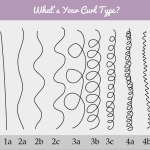Are all kinks made equally? Many people debate that hair typing is very unnecessary, a waste of time even. Hair typing is about more than seperating your kinks from the kinks of the woman next to you. It’s important to know what type of hair you have to determine the appropriate products for your mane. Not everyone’s hair responds to the same type of products, and knowing your hair type can be helpful when it comes to caring for your hair.
The most common hair typing system is the Andre Walker system. In his system, t he hair types are graded from straight to coily hair, with each term referring to your hair strands. Type 1 hair is straight, Type 2 hair is wavy, Type 3 hair is curly hair, and Type 4 hair is kinky hair. Each hair type has subgroups that go into more specifics.
Hair types Products
Type 1
Straight, fine, resistant to curly styling
Avoid heavy products which can your fine strands to fall flat. Look for “thickening” or “volumizing” products.
Shampoo and condition daily
Pick mousse over gel
Type 2
Fine, has waves, relatively coarse, tends to frizz
Shampoo daily (or every other day), but DO NOT skip conditioning to fight frizz
Use gentle cleansers and silicone free products that won’t weigh your hair down
Look for “thickening” and “volumizing products
Mousse and gels may work for your hair (gel better for 2c)
Type 3
Shiny and loose, bouncy or tight corkscrews and curls
Shampoo 1-2 times per week, condition each time (more often won’t hurt either)
Use gels and styling creams to help contain frizz
Choose gentle cleansers (sulfate free)
Moisturizing is very important (creams with extra moisture are good)
Type 4
Tighter coils, curl patterns tend to have less definition
Due to frizz, conditioner is most important
Condition 3-4 times as much as you shampoo
Choose products that will be easy on your hair (sulfate free products)
The super tight coils call for more moisturizing (WATER) due to your hair’s ability to drying out
Use creams and butters to seal in moisture
—
So a little more details about type 4 hair care:
Type 4 hair requires extra care. The tightness of the coils makes this type of hair prone to drying out. You should be moisturizing daily (water is the most natural moisturizer, and your best option), sealing in the moisture after with oil. If you choose not to use water to moisturize, a thick, creamy moisturizer will probably benefit your hair the most.
Many people with type 4 hair opt to cleanse with conditioner rather than shampoo because of it’s potential to strip your hair of its natural oils. Your hair will benefit from more conditioning than shampooing, but it’s still important to shampoo. Once a month, using a clarifying shampoo, free of sulfates, helps keep product build up at bay. Washing your hair in small sections will help prevent further tangling and while you’re at it, you can finger detangle.
Co-washing and deep conditioning will probably be the most important part of your regimen. Deep conditioning helps restore moisture and make your hair easy to manage. It is especially important if your hair tends to be dry or brittle. This can be done once a week, prior to shampooing to help add some extra protection. You can use a homemade deep conditioning treatment or you can use a product that says deep conditioner/hair treatment/hair mask, after which you can apply heat (either by sitting under a dryer for 15-20 minutes or by wearing a shower cap and relying on your body’s natural heat as long as you’d like). Co-washing can be done once a week as well. It should be performed like shampooing – in smaller sections, using your fingers to detangle. Your hair should only be detangled when wet.
You should try your best to protect your ends at all times. Protective styling is the key to preventing breaking and retaining length. Low manipulation will also help to retain moisture. Your hair should be protected at night. Wearing a satin cap/using a satin pillowcase will also decrease friction and prevent breakage.
[by Sophonie]





